 After hearing Titania,I was eager to know what Michael Turner could do by himself. Angelmarkis his solo project that consists of various electronic flourishes, sixand twelve-string guitars, both electric and acoustic, piano, andpercussive elements. Angelmark is produced so that the aura of the album has the same infinite feeling as Titania,the instrumentation, movements, and attitude are unique. Many of thesongs are pastoral sounding and recall the beauty of a sun-struckprairie while others emit a cool glow that paints a full moon above thecold air interrupted only be the tops of the tallest and most jaggedtrees. The most stunning moments on the album manage to mix somber andhopeful themes together without being overwhelming, but there are othermoments when the music feels like a funeral procession. Some of thesongs, such as "Wave Upon Wave" sound as if they are lacking somethingand the thought springs to mind that perhaps Mandy Cousins could'vedone something with these songs that Turner cannot do alone. Withouther voice, some of these tracks sound a bit too synthetic and they losesome of their emotional appeal. On the other hand there are tracks like"Light-Splintered Eye" and "Like Places We've Been" that manage to walkthat blurred line between a funeral shroud and the brilliance of thesun. The latter is a particularly haunting duel between acoustic guitarand a horn-like synthesizer part that seeps and crawls through thecracks in the walls as if it were after something very important andvery hidden. The swirling of guitars and keyboards meshes in someplaces and at other times borders a bit on the predictable. Angelmarkdoesn't quite hit the same soft-spot that Turner's other project did,but there are some undeniably fine songs to be heard on this disc.
After hearing Titania,I was eager to know what Michael Turner could do by himself. Angelmarkis his solo project that consists of various electronic flourishes, sixand twelve-string guitars, both electric and acoustic, piano, andpercussive elements. Angelmark is produced so that the aura of the album has the same infinite feeling as Titania,the instrumentation, movements, and attitude are unique. Many of thesongs are pastoral sounding and recall the beauty of a sun-struckprairie while others emit a cool glow that paints a full moon above thecold air interrupted only be the tops of the tallest and most jaggedtrees. The most stunning moments on the album manage to mix somber andhopeful themes together without being overwhelming, but there are othermoments when the music feels like a funeral procession. Some of thesongs, such as "Wave Upon Wave" sound as if they are lacking somethingand the thought springs to mind that perhaps Mandy Cousins could'vedone something with these songs that Turner cannot do alone. Withouther voice, some of these tracks sound a bit too synthetic and they losesome of their emotional appeal. On the other hand there are tracks like"Light-Splintered Eye" and "Like Places We've Been" that manage to walkthat blurred line between a funeral shroud and the brilliance of thesun. The latter is a particularly haunting duel between acoustic guitarand a horn-like synthesizer part that seeps and crawls through thecracks in the walls as if it were after something very important andvery hidden. The swirling of guitars and keyboards meshes in someplaces and at other times borders a bit on the predictable. Angelmarkdoesn't quite hit the same soft-spot that Turner's other project did,but there are some undeniably fine songs to be heard on this disc.
Two new shows just for you. We have squeezed out two extended release episodes for this weekend to get you through this week. They contain mostly new songs but there's also new issues from the vaults. The first show features music from Rider/Horse, Mint Field, Robert Aiki Aubrey Lowe, Anastasia Coope, ISAN, Stone Music, La Securite, Bark Psychosis, Jon Rose, Master Wilburn Burchette, Umberto, Wand, Tim Koh, Sun An, and Memory Drawings. The second episode has music by Laibach, Melt-Banana, Chuck Johnson, X, K. Yoshimatsu, Dorothy Carter, Pavel Milyakov, Violence Gratuite, Mark Templeton, Dummy, Endon, body / negative, Midwife, Alberto Boccardi, Divine. Cow in Maui from Veronika in Vienna. Get involved: subscribe, review, rate, share with your friends, send images! |



 Another piece of the art-rock puzzle is uncovered with the release ofthis three-disc box set containing the entire recorded output ofMexican progressive band Decibel. Part of the Rock In Opposition (RIO)— a South American political movement utilizing art and music asaesthetic protest — Decibel never gained the recognition of theirEuropean art-rock contemporaries. Considering the band's exclusivelyMexican membership, Decibel's sound is surprisingly informed solely bytheir European counterparts, namely bands like Art Bears, Art Zoyd andMagma. It's a shame that the influences of indigenous Mexican cultureand music haven't seeped into Decibel's intellectual Euro-prog in anyrecognizable form, as this would easily set them apart from theirpredecessors. But who am I to question their aesthetic choices? Thefirst disc contains their first LP El Poeta del Ruido(The Poet of Noise), and it's quite an impressive debut. The firsttrack lands right in the middle of some overly familiar jazz-rockterritory: guitars, drums, keyboards and saxophone running aimlesslythrough high-velocity, complex chord changes, showing off theirinstrumental virtuosity. It's all technically impressive but not veryemotionally resonant, the same criticism that could be easily leveledagainst a lot of late-70s art-prog. Quickly and quite unexpectedly,however, the band ushers us the two-track song suite "OrgonPatafisico," a tribute to the Orgone theories of Wilhelm Reich thatbegins with a demented music box melody and soon gives way to a dark,psychedelic soundscape populated by eerie synthesizer swoops andskeletal guitar deconstructions. It's a beautifully realized track,holding the same fascination as early Nurse With Wound material. Infact, if Steven Stapleton had heard this album back in 1979, I'm quitecertain Decibel would have been on the infamous NWW influence listright between Decayes and Dedalus. The rest of the album is similarlyunhinged, proficiently played jazz passages floating around in strangecosmic byways and dark catacombs. "Terapia de Fakirato" is a standouttrack, beginning with an achingly fragile piano refrain before the restof the band join in, transforming the track into a hauntingly beautifuldirge. The rhythm section of Decibel deserves special credit,delivering the propulsive backbone upon which the players bounce andswerve. "Manati" is pure ensemble insanity, a dense jungle swamppopulated by strange birds and pygmies tripping on yage. The rest ofthe first disc is taken up with live material from their early period,proving that Decibel knew how to recreate their studio magic in aconcert setting. Lap dissolve to 12 years later, it's 1992 and Decibelhave reformed and recorded a new LP Fortuna Virilis, which isworthy, but never really recaptures the enigmatic brilliance of theirearlier material. Still, it's hard not to appreciate "Maldoror,"Decibel's ode to Isidore Ducasse's surreal masterwork, a slowlysimmering track decorated with the random squeals of an infant. Discthree consists of live material from a 2000 concert, which begins ingrandiose Magma style before morphing into the future-primitive improvsof "Suite Safari." The rest of disc three contains demos from as earlyas 1977. These are poorly recorded but allow us to hear songs from the PoetaLP in their nascent form. It should also be noted that this box set isbeautifully packaged, containing all of the Goya-esque corpse portraitsthat adorned Decibel's original sleeves, along with informative linernotes. Taken together, Fiat Lux: The Complete Recordings is an impressive listen, and the definitive career retrospective of this unjustly obscure band.
Another piece of the art-rock puzzle is uncovered with the release ofthis three-disc box set containing the entire recorded output ofMexican progressive band Decibel. Part of the Rock In Opposition (RIO)— a South American political movement utilizing art and music asaesthetic protest — Decibel never gained the recognition of theirEuropean art-rock contemporaries. Considering the band's exclusivelyMexican membership, Decibel's sound is surprisingly informed solely bytheir European counterparts, namely bands like Art Bears, Art Zoyd andMagma. It's a shame that the influences of indigenous Mexican cultureand music haven't seeped into Decibel's intellectual Euro-prog in anyrecognizable form, as this would easily set them apart from theirpredecessors. But who am I to question their aesthetic choices? Thefirst disc contains their first LP El Poeta del Ruido(The Poet of Noise), and it's quite an impressive debut. The firsttrack lands right in the middle of some overly familiar jazz-rockterritory: guitars, drums, keyboards and saxophone running aimlesslythrough high-velocity, complex chord changes, showing off theirinstrumental virtuosity. It's all technically impressive but not veryemotionally resonant, the same criticism that could be easily leveledagainst a lot of late-70s art-prog. Quickly and quite unexpectedly,however, the band ushers us the two-track song suite "OrgonPatafisico," a tribute to the Orgone theories of Wilhelm Reich thatbegins with a demented music box melody and soon gives way to a dark,psychedelic soundscape populated by eerie synthesizer swoops andskeletal guitar deconstructions. It's a beautifully realized track,holding the same fascination as early Nurse With Wound material. Infact, if Steven Stapleton had heard this album back in 1979, I'm quitecertain Decibel would have been on the infamous NWW influence listright between Decayes and Dedalus. The rest of the album is similarlyunhinged, proficiently played jazz passages floating around in strangecosmic byways and dark catacombs. "Terapia de Fakirato" is a standouttrack, beginning with an achingly fragile piano refrain before the restof the band join in, transforming the track into a hauntingly beautifuldirge. The rhythm section of Decibel deserves special credit,delivering the propulsive backbone upon which the players bounce andswerve. "Manati" is pure ensemble insanity, a dense jungle swamppopulated by strange birds and pygmies tripping on yage. The rest ofthe first disc is taken up with live material from their early period,proving that Decibel knew how to recreate their studio magic in aconcert setting. Lap dissolve to 12 years later, it's 1992 and Decibelhave reformed and recorded a new LP Fortuna Virilis, which isworthy, but never really recaptures the enigmatic brilliance of theirearlier material. Still, it's hard not to appreciate "Maldoror,"Decibel's ode to Isidore Ducasse's surreal masterwork, a slowlysimmering track decorated with the random squeals of an infant. Discthree consists of live material from a 2000 concert, which begins ingrandiose Magma style before morphing into the future-primitive improvsof "Suite Safari." The rest of disc three contains demos from as earlyas 1977. These are poorly recorded but allow us to hear songs from the PoetaLP in their nascent form. It should also be noted that this box set isbeautifully packaged, containing all of the Goya-esque corpse portraitsthat adorned Decibel's original sleeves, along with informative linernotes. Taken together, Fiat Lux: The Complete Recordings is an impressive listen, and the definitive career retrospective of this unjustly obscure band. Listening to Hung By The Dick, it doesn't take very long to figure out that Costes is a bigoted, phallocentric, scatological Frenchman with a misanthropic hatred for every institution imaginable. The scrawl on the back cover says it all: "I hate my race, I hate myself, but I like my dick."
Listening to Hung By The Dick, it doesn't take very long to figure out that Costes is a bigoted, phallocentric, scatological Frenchman with a misanthropic hatred for every institution imaginable. The scrawl on the back cover says it all: "I hate my race, I hate myself, but I like my dick." Eric Aldea and Ivan Chiossone originally intended Narcophony to be an adaptation of Nurse With Wound's classic 1986 work Spiral Insanafor strings. As the project evolved beyond its original genesis, theydecided instead to create a work that was inspired and suggested by theSteven Stapleton masterwork, rather than a true adaptation. What hasresulted is an album of quiet intensity and true beauty. Spiral Insanastands as Nurse With Wound's most emotionally affecting work; the oneinstance where Stapleton abandoned the clinical distance with which heusually approaches his soundscapes. Narcophony is a similarlyaffecting work; a five-part chamber symphony that envelops the listenerin a spectral wasteland of dread and beauty. Using an ensemble of threeviolins, a viola, a clarinet, a bass and a flute, and Aldea on acousticguitar and "machines," these two artists have created a compellingorchestral work that is all the more amazing for its intense subtlety.The first track places the listener into the moody ambience of a darkforest at night, the distant echoing cries of a sad bird, the pregnanttwilight pushing down on the soul of a lone wanderer. A chorus ofghostly creatures cry out, desperately attempting to push their wayinto cohesion. Their cries fade into the distance. Extinguishedbonfires curl and billow fragrant smoke. The slick surface of wetbranches appear shiny in the moonlight. The forest is a dead museum. Iam reminded of the hauntingly spectral sound design and darksynthscapes that accompanied the night scenes in David Lynch's Twin Peaks: Fire Walk With Me.By the time I reach the third track, I am absolutely transfixed by thisquiet drama; the flutes and synthesizers are sculpting nonsensicalheiroglyphs into my brain. The synthesizer arpeggiations and chirpstake precedence on track four, before being jaggedly torn from the pageand replaced by a series of bubbling electronic swells. After thefive-part song suite of "Petit Buddha," there are two additional songson the disc: "Leo," a lovely ethnic-inflected excursion by IvanChiossone and "Hasmig," another collaboration that highlights Aldea'sguitar and swooping string arrangements. The fragile and sonorous musicmade by Aldea and Chiossone's chamber ensemble is remarkable for itsincredible poise, deep passion and enigmatic resonance. Narcophony is the sound of mystery in motion.
Eric Aldea and Ivan Chiossone originally intended Narcophony to be an adaptation of Nurse With Wound's classic 1986 work Spiral Insanafor strings. As the project evolved beyond its original genesis, theydecided instead to create a work that was inspired and suggested by theSteven Stapleton masterwork, rather than a true adaptation. What hasresulted is an album of quiet intensity and true beauty. Spiral Insanastands as Nurse With Wound's most emotionally affecting work; the oneinstance where Stapleton abandoned the clinical distance with which heusually approaches his soundscapes. Narcophony is a similarlyaffecting work; a five-part chamber symphony that envelops the listenerin a spectral wasteland of dread and beauty. Using an ensemble of threeviolins, a viola, a clarinet, a bass and a flute, and Aldea on acousticguitar and "machines," these two artists have created a compellingorchestral work that is all the more amazing for its intense subtlety.The first track places the listener into the moody ambience of a darkforest at night, the distant echoing cries of a sad bird, the pregnanttwilight pushing down on the soul of a lone wanderer. A chorus ofghostly creatures cry out, desperately attempting to push their wayinto cohesion. Their cries fade into the distance. Extinguishedbonfires curl and billow fragrant smoke. The slick surface of wetbranches appear shiny in the moonlight. The forest is a dead museum. Iam reminded of the hauntingly spectral sound design and darksynthscapes that accompanied the night scenes in David Lynch's Twin Peaks: Fire Walk With Me.By the time I reach the third track, I am absolutely transfixed by thisquiet drama; the flutes and synthesizers are sculpting nonsensicalheiroglyphs into my brain. The synthesizer arpeggiations and chirpstake precedence on track four, before being jaggedly torn from the pageand replaced by a series of bubbling electronic swells. After thefive-part song suite of "Petit Buddha," there are two additional songson the disc: "Leo," a lovely ethnic-inflected excursion by IvanChiossone and "Hasmig," another collaboration that highlights Aldea'sguitar and swooping string arrangements. The fragile and sonorous musicmade by Aldea and Chiossone's chamber ensemble is remarkable for itsincredible poise, deep passion and enigmatic resonance. Narcophony is the sound of mystery in motion.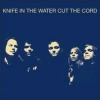 Austin's own Knife in the Water craft an interesting mix of a variety of musical styles into haunting, purposeful dirges that can scourge the light into non-existence. One of the first signings to the new Aspyr label — an off-shoot of the popular software company — the band is re-releasing all their previous recordings along with this album of new material. This is not the same music that was voted into Spin's Top 20 of 2000, but it is the same band all grown up and grown into their relationship.
Austin's own Knife in the Water craft an interesting mix of a variety of musical styles into haunting, purposeful dirges that can scourge the light into non-existence. One of the first signings to the new Aspyr label ‚Äî an off-shoot of the popular software company ‚Äî the band is re-releasing all their previous recordings along with this album of new material. This is not the same music that was voted into Spin's Top 20 of 2000, but it is the same band all grown up and grown into their relationship.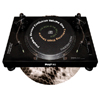 I had to suppress my hatred of shape-CDs and my distaste for artistswho name themselves mockingly after other artists in order to give thisdisc its proper due. I had expected another insubstantialpost-Pluderphonics parody fest. Instead I got one very substantialnoise piece that, at 20 minutes, never wears out its welcome and evenbears repeating. Playback Device is turntable music recorded live atMego hangout Bar Rhiz this February. The most prominent sounds in thepiece are distorted or already painfully noisy records in the processof deceleration, spaced by heavily cut-up and layered human screams. Tothis intimidating background, Empire adds bits of laughing, childrentalking, punk-ish German singing, creaking door sounds, and hummingmotor noise. Submerged breakbeats, death metal guitar, and ten secondsof bouncy dub all enter the mix. Empire is on his toes for theduration, constantly throwing new records into the mix and bringing themass to precarious stops. Though the piece never gets boring and ismore likely to send the listener into his or her own screaming fit, itdoes have a few highpoints. The first is the rather enlightening momentwhen one voice (perhaps Empire's own) rises above the fray to yell"Fuck You" a dozen times, and the second is the track's closingsection. At around 19 minutes the noise drops out, replaced by atwisted, naïvely-styled ditty with a vocalist intent on communicatinghow happy his life was until his mommy and daddy were murdered inAuschwitz. Playback Deviceends with this singer, whose gruff voice sounds live from behind thedecks, screaming "Nazis!" repeatedly. And I thought it was going to befunny! All things considered, this disc is still more pleasant thansome Mego fair, and certainly less intellectual, a good thing (justthis once).
I had to suppress my hatred of shape-CDs and my distaste for artistswho name themselves mockingly after other artists in order to give thisdisc its proper due. I had expected another insubstantialpost-Pluderphonics parody fest. Instead I got one very substantialnoise piece that, at 20 minutes, never wears out its welcome and evenbears repeating. Playback Device is turntable music recorded live atMego hangout Bar Rhiz this February. The most prominent sounds in thepiece are distorted or already painfully noisy records in the processof deceleration, spaced by heavily cut-up and layered human screams. Tothis intimidating background, Empire adds bits of laughing, childrentalking, punk-ish German singing, creaking door sounds, and hummingmotor noise. Submerged breakbeats, death metal guitar, and ten secondsof bouncy dub all enter the mix. Empire is on his toes for theduration, constantly throwing new records into the mix and bringing themass to precarious stops. Though the piece never gets boring and ismore likely to send the listener into his or her own screaming fit, itdoes have a few highpoints. The first is the rather enlightening momentwhen one voice (perhaps Empire's own) rises above the fray to yell"Fuck You" a dozen times, and the second is the track's closingsection. At around 19 minutes the noise drops out, replaced by atwisted, naïvely-styled ditty with a vocalist intent on communicatinghow happy his life was until his mommy and daddy were murdered inAuschwitz. Playback Deviceends with this singer, whose gruff voice sounds live from behind thedecks, screaming "Nazis!" repeatedly. And I thought it was going to befunny! All things considered, this disc is still more pleasant thansome Mego fair, and certainly less intellectual, a good thing (justthis once). 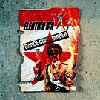 The Electric Six are most definitely a singles band. Admit it, as muchas you pretend to hate their trashy, sleazy hard rock disco, "Danger!High Voltage" got your ears perking and ass moving. So the LP wasn'tspectacular, but hey, you try keeping up the amphetamine laced worshipof fire, dancing, and the night for over a half hour (Please do notrespond with personal anecdotes of how you did this last solstice). Ifanything, the Dance Commander single will redeem the band to those who found themselves somewhat disappointed in Fire.Though "Dance Commander" is one of the better LP tracks, and anexcellent choice to stand on it's own as a single, it is the other twotracks that truly make an impression. The first is "I Am Detroit," ageographical conversation between said city and other notable locales,inviting them to tango on the dance floor of America. Luckily, theElectric Six is just the band with enough misguided confidence and zealto adopt the personification of an entire city and start makingdemands. It's a rhythm heavy rocker that will please both head boppersand hip shakers alike. The third track is a remix of "Dance Commander"by Soulchild that annihilates the original version. Gone are theoverbearing hard rock guitars, replaced by a jangly, rhythmic staccatostrum and layers of synthesizers. This is the type of music that makesthe Electric Six interesting, relentlessly danceable, musically daring,and totally pulling off their attitude, that seems to amount to "we'reso fucking serious about not being serious." With the new beat, thebest aspects of "Dance Commander" become more apparent, and when singerDick Valentine growls out "I went to the store / to get more / FIRE /to start the war!" it is utterly convincing, and phrased soexcellently. The Electric Six know what they like, and they're veryclear about it. "It would be awesome if we could dance" Who cares ifit's not deep or profound. It would be awesome if we could dance, and this single goes a long way to fulfilling that desire.
The Electric Six are most definitely a singles band. Admit it, as muchas you pretend to hate their trashy, sleazy hard rock disco, "Danger!High Voltage" got your ears perking and ass moving. So the LP wasn'tspectacular, but hey, you try keeping up the amphetamine laced worshipof fire, dancing, and the night for over a half hour (Please do notrespond with personal anecdotes of how you did this last solstice). Ifanything, the Dance Commander single will redeem the band to those who found themselves somewhat disappointed in Fire.Though "Dance Commander" is one of the better LP tracks, and anexcellent choice to stand on it's own as a single, it is the other twotracks that truly make an impression. The first is "I Am Detroit," ageographical conversation between said city and other notable locales,inviting them to tango on the dance floor of America. Luckily, theElectric Six is just the band with enough misguided confidence and zealto adopt the personification of an entire city and start makingdemands. It's a rhythm heavy rocker that will please both head boppersand hip shakers alike. The third track is a remix of "Dance Commander"by Soulchild that annihilates the original version. Gone are theoverbearing hard rock guitars, replaced by a jangly, rhythmic staccatostrum and layers of synthesizers. This is the type of music that makesthe Electric Six interesting, relentlessly danceable, musically daring,and totally pulling off their attitude, that seems to amount to "we'reso fucking serious about not being serious." With the new beat, thebest aspects of "Dance Commander" become more apparent, and when singerDick Valentine growls out "I went to the store / to get more / FIRE /to start the war!" it is utterly convincing, and phrased soexcellently. The Electric Six know what they like, and they're veryclear about it. "It would be awesome if we could dance" Who cares ifit's not deep or profound. It would be awesome if we could dance, and this single goes a long way to fulfilling that desire. A song that can weave itself into your consciousness and stay there hours, days, even weeks after hearing it is a powerful thing, like it or not. However, when it coincides with a song you love, it's cosmic. "Crazy Love" first popped up on the Channel 2 compilation from Output. Since then, the song has honestly been on endless repeat both on my CD player and in my head until I finally caved in to buy the debut album from this one man band. Marc Nguyen Tan must have an affinity for Suicide, Joy Division and early New Order, old school dub, and a few other things I'm having a hard time putting my finger on. The music, like some of my all time favorites, is driven by some mesmerising hooks: simple and direct with hypnotic bass, guitar and synth melodies and repetitious drum machine patterns. They're good enough -not- to be complicated by solo wankery, breakbeats, or anything unnecessary. Tan's voice is pretty damned sexy for a Vietnamese Parisian, as muttered through faint echoes on nearly everything. The disc wastes no time and opens with the aforementioned song I've been craving, and continues on through "Confusion," a tune which sounds like an homage to the better remixes of the 1980s, and a sinfully enjoyable dub tribute "One Night In Tokyo." There are moments where the Movement-era New Order is TOO apparent, as the song "Where" comes way too close to echoing Stephen Morris' drums from "The Him," but it's easily forgivable as Tan takes the music further with songs like "This River," filling in the emptiness colorfully with tinkling piano and dissonant guitars. As a person who wouldn't like to live in regret, I -had- to get this before it's too late as the limited edition has started to become scarce. The first run of the release is accompanied with a DVD of some "short films" of five of the album's tracks. The videos aren't anything groundbreaking or high budget, but it's a pleasurable visual accompaniment and highly recommendable for other labels to seriously start considering.
A song that can weave itself into your consciousness and stay there hours, days, even weeks after hearing it is a powerful thing, like it or not. However, when it coincides with a song you love, it's cosmic. "Crazy Love" first popped up on the Channel 2 compilation from Output. Since then, the song has honestly been on endless repeat both on my CD player and in my head until I finally caved in to buy the debut album from this one man band. Marc Nguyen Tan must have an affinity for Suicide, Joy Division and early New Order, old school dub, and a few other things I'm having a hard time putting my finger on. The music, like some of my all time favorites, is driven by some mesmerising hooks: simple and direct with hypnotic bass, guitar and synth melodies and repetitious drum machine patterns. They're good enough -not- to be complicated by solo wankery, breakbeats, or anything unnecessary. Tan's voice is pretty damned sexy for a Vietnamese Parisian, as muttered through faint echoes on nearly everything. The disc wastes no time and opens with the aforementioned song I've been craving, and continues on through "Confusion," a tune which sounds like an homage to the better remixes of the 1980s, and a sinfully enjoyable dub tribute "One Night In Tokyo." There are moments where the Movement-era New Order is TOO apparent, as the song "Where" comes way too close to echoing Stephen Morris' drums from "The Him," but it's easily forgivable as Tan takes the music further with songs like "This River," filling in the emptiness colorfully with tinkling piano and dissonant guitars. As a person who wouldn't like to live in regret, I -had- to get this before it's too late as the limited edition has started to become scarce. The first run of the release is accompanied with a DVD of some "short films" of five of the album's tracks. The videos aren't anything groundbreaking or high budget, but it's a pleasurable visual accompaniment and highly recommendable for other labels to seriously start considering. 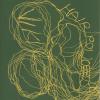 Maybe it's because I heard the song a good ten years after itscreation, but I still have a hard time getting my head around SonicYouth's "Death Valley 69." While I can appreciate the song for what itis, a blasted city-dweller's meditation on the desolate West, and allthe kitsch-laden horror stories coming with it, I've never been able toget as much from the listening experience. All the gratuitous filth andtheatrics just haven't mixed right with a real barrenness alsoprojected by the song. Luckily, there are people in Michigan today whoshoulder this dichotomy with ease. Dearborn's Viki plays afrighteningly arid brand of electro, fattened by an upbringing inAmerica's industrial waist, and packed with enough obtuse humor to keepyour eyes watery without quenching the scorched landscape of the music.She has an eerie, Lydia Lunch-ian delivery, twisting crazed yarns ondating, muscle-car culture, and thin lifestyle advice, over ricketybeats and the squelch of cheap electronics. The result is a more agileversion of the crawling beast conjured by Ann Arbor, Michigan's WolfEyes, with an added resilience to make it all the more menacing. Vikiconvinces me that she lives under the same crumbling off-ramps broughtto life in her songs, while cracking jokes in same breath. No smallfeat…and you can almost dance to it. Kentucky's Hair Police are a tadharder to pin down. On last year's Blow Out Your Bloodthey produced thoroughly abrasive, art-damaged rock, the sounds ofvocals or even drums rarely piercing massive walls of distortion andshattered electronic noise. This release sees them in an even greaterstate of shambles, the bursts of noise and effected screams displacedby longer, more spacious sections of rumbling static and destroyedguttural sounds. Even the song titles, like "Night Visitors" and "NotRaft, But Cage" reveal a more sinister, if less bombastic approach thanprevious efforts, bearing titles like "Do You Love Hop Hop?" and "MagicTool, A Big Hammer." If this is the new Americana, I'm sold.
Maybe it's because I heard the song a good ten years after itscreation, but I still have a hard time getting my head around SonicYouth's "Death Valley 69." While I can appreciate the song for what itis, a blasted city-dweller's meditation on the desolate West, and allthe kitsch-laden horror stories coming with it, I've never been able toget as much from the listening experience. All the gratuitous filth andtheatrics just haven't mixed right with a real barrenness alsoprojected by the song. Luckily, there are people in Michigan today whoshoulder this dichotomy with ease. Dearborn's Viki plays afrighteningly arid brand of electro, fattened by an upbringing inAmerica's industrial waist, and packed with enough obtuse humor to keepyour eyes watery without quenching the scorched landscape of the music.She has an eerie, Lydia Lunch-ian delivery, twisting crazed yarns ondating, muscle-car culture, and thin lifestyle advice, over ricketybeats and the squelch of cheap electronics. The result is a more agileversion of the crawling beast conjured by Ann Arbor, Michigan's WolfEyes, with an added resilience to make it all the more menacing. Vikiconvinces me that she lives under the same crumbling off-ramps broughtto life in her songs, while cracking jokes in same breath. No smallfeat…and you can almost dance to it. Kentucky's Hair Police are a tadharder to pin down. On last year's Blow Out Your Bloodthey produced thoroughly abrasive, art-damaged rock, the sounds ofvocals or even drums rarely piercing massive walls of distortion andshattered electronic noise. This release sees them in an even greaterstate of shambles, the bursts of noise and effected screams displacedby longer, more spacious sections of rumbling static and destroyedguttural sounds. Even the song titles, like "Night Visitors" and "NotRaft, But Cage" reveal a more sinister, if less bombastic approach thanprevious efforts, bearing titles like "Do You Love Hop Hop?" and "MagicTool, A Big Hammer." If this is the new Americana, I'm sold.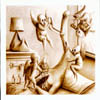 In 1690, John Locke said: "Time is to duration as place is to expansion, and whoever pursues his own thoughts, will find them sometimes launch out beyond the extent of body, into the infinity of space or expansion; the idea whereof is distinct and separate from body and all other things." irr.app.(ext.) says: "Herein, which is the structurelessness of insignificance, possibility is given a reign of manifestation no longer limited by the constraints of possibility, the which can be considered the body."
In 1690, John Locke said: "Time is to duration as place is to expansion, and whoever pursues his own thoughts, will find them sometimes launch out beyond the extent of body, into the infinity of space or expansion; the idea whereof is distinct and separate from body and all other things." irr.app.(ext.) says: "Herein, which is the structurelessness of insignificance, possibility is given a reign of manifestation no longer limited by the constraints of possibility, the which can be considered the body." 
